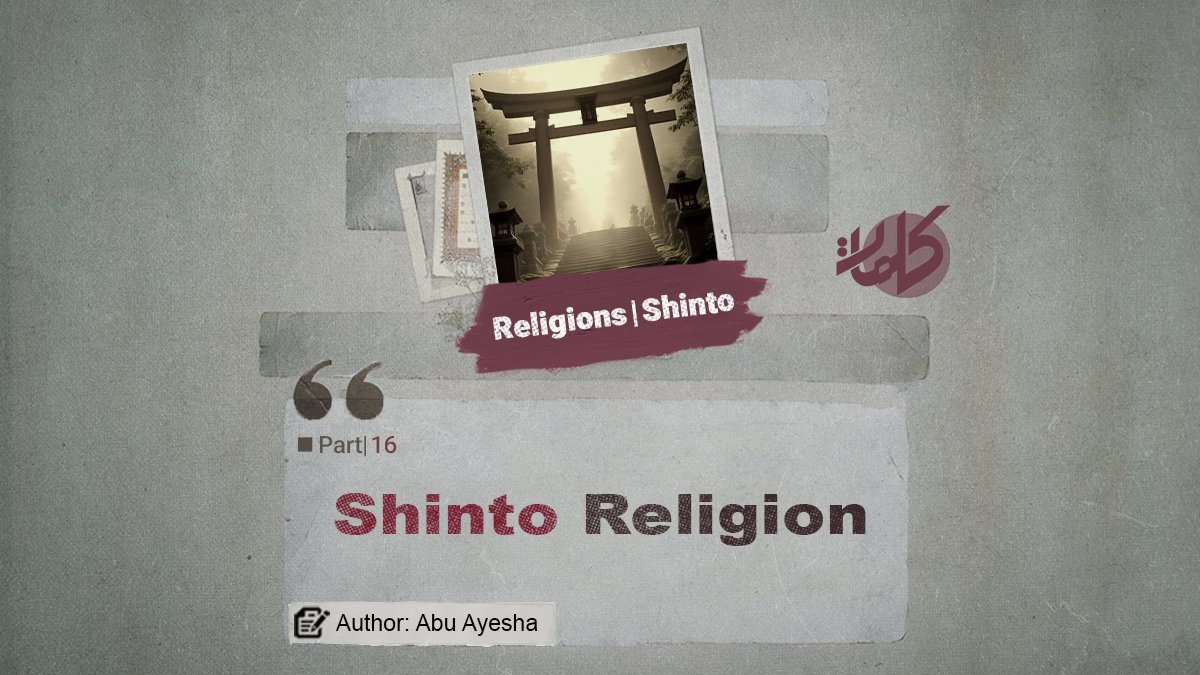Author: Abu Ayesha
Shinto Religion (Part 16)
Introduction:
As previously mentioned, the Shinto religion has gone through several distinct periods — those before and after the birth of Christ. The earlier period marks the beginning and formation of Shinto and its various rituals, while the later period represents its flourishing, growth, and gradual organization into an official system. However, this religion did not remain complete and unified forever; over time, it lost many of its followers and eventually turned into a sect.
In the previous part, we discussed the Bushido rituals — one of the most prominent ceremonies in Shinto — as well as the books written in this tradition, its fluctuations, and the biographies of the emperors of Japan. In this section, we will examine the various stages that Shinto has undergone throughout history.
When and how did these transformations occur?
The Shinto religion has experienced numerous phases. At different times, it was influenced by and intertwined with other religions such as Buddhism, Confucianism, Taoism, and Christianity. However, this interconnection weakened from the 13th century onwards, and by the late 18th century, Shinto had achieved relative independence from other religions. [1]
To understand the different states Shinto has gone through from its origin until now, we summarize the discussion found in A History of Religions by John Noss — a well-known and authoritative work frequently cited by scholars writing about Shinto.
The Renewal of Shinto in the 17th Century
Despite the emergence of certain priestly classes during the period of Shinto–Buddhist amalgamation who sought to restore Shinto to its original purity — asserting that the worship of Kami was an intrinsic part of Japanese belief while the worship of Buddhist deities was merely external — they based their teachings on the doctrine of the emperor’s divine ancestry, tracing his lineage back to Amaterasu, the sun goddess.
During this time, several political and social events also unfolded. The number of Japanese Christians — whose faith had been introduced by Saint Francis Xavier in 1549 — grew to 300,000 by the 17th century, but they faced severe persecution. Meanwhile, the Shoguns (military rulers) seized power from the emperor, and Japan was closed to foreign ships for two centuries.
In this era, a number of Shinto scholars appeared in the temples, inspired by rising patriotism and the desire to restore the old Japanese faith. They called their movement “The Ancient True Way.” One of the most famous among them was Motoori Norinaga, a distinguished scholar whose works in both religion and history remain highly respected in Japan. He passionately defended ancient Japanese beliefs, asserting that no nation was equal to the Japanese people, since their emperor was the only monarch descended directly from the gods. Consequently, he rejected the teachings of Buddha and Confucius — which he viewed as foreign imports — and claimed that Japan, through its divine lineage, was capable of defining its own moral and spiritual principles independently. He insisted that the simple, ancestral Shinto way was the one true religion. [2]
The Crisis of the 19th Century (1868)
Despite these intellectual and political developments, the Japanese people did not easily abandon their customs. Many continued to follow Buddhism and Confucianism until the mid-19th century, when sudden changes reshaped Japan.
Although Japan had long isolated itself from the outside world, American whaling ships occasionally reached its shores due to shipwrecks or shortages of supplies. Initially, the Japanese labeled these sailors as “foreign devils” and executed them, but later they began returning the survivors to their homelands through Dutch intermediaries — the only foreigners permitted to trade in Japan.
Eventually, U.S. President Millard Fillmore (1850–1853) sent a letter to the Japanese emperor, delivered by Commodore Matthew Perry, requesting that American ships be allowed to anchor at certain Japanese ports. Perry arrived in 1854 with ten warships and two thousand soldiers, compelling the Shogun to sign a treaty allowing shipwrecked sailors to be treated kindly, permitting foreign ships to establish supply depots, and opening three small ports to foreign trade.
However, this treaty was not ratified by the emperor, leading to conflict between the Shogun and the imperial court. In 1868, the Shogunate was overthrown, and all authority returned to the emperor — marking the beginning of the Meiji Restoration.
Under Emperor Meiji, Japan embarked on an extraordinary process of modernization. Realizing that their old defenses were no match for Western powers, the Japanese rapidly developed their military, industrial, and economic sectors. This transformation inevitably changed Japan’s culture, which began to merge ancient traditions with modern systems.
In 1889, Japan adopted its first constitution, establishing a unified nation under the emperor. The Shinto belief in the emperor’s divine descent once again became the cornerstone of Japan’s political and social life. The constitution granted the emperor eternal sovereignty and immunity, effectively elevating Shinto to the status of a state religion — distinct from Buddhism and other faiths. [3]
When Emperor Meiji took power, one of his first decrees was to declare Shinto the official state religion and to remove all Buddhist elements from its shrines. Although this purification was at first enforced with some degree of coercion, it soon became evident that a complete separation of Buddhism and Shinto was impractical, as the people remained deeply attached to both traditions.
Ultimately, the 1889 Constitution granted full religious freedom to all citizens, but the state continued to favor Shinto. A special government bureau dedicated to Shinto affairs was established within the Ministries of the Interior and Education, distinguishing between “State Shinto” (official) and “National Shinto” (popular). [3]
With the beginning of the Meiji era and the end of the Tokugawa Shogunate, a new class of Western-educated elites rose to power. These leaders sought to modernize Japan by creating a centralized political system modeled after Germany and Prussia — an absolute monarchy under a constitution. Deliberately avoiding democracy, they viewed national progress as dependent on a strong, centralized state.
Drawing inspiration from the National Learning School (Kokugaku), they adopted Shinto as the ideological foundation legitimizing their political system. After the emperor’s political authority was restored in 1868, Kami Kurume, the lord of Tsuwano Province, was appointed Director of Theology and led the movement to revive Shinto throughout Japan. One of his first actions was to purge Buddhist symbols from Shinto shrines and restore them to their original purity. [4]
Although major efforts were made to revive Shinto and restore its former glory, it lacked divine revelation and, therefore, could not serve as a comprehensive spiritual guide. Moreover, the government itself sought to limit its authority to avoid potential restrictions it could impose on the rulers.
Once Shinto became the official religion of the state and its shrines were purified of Buddhist elements, significant changes emerged in every aspect of the faith. Shinto expanded so widely among the people that it transcended the boundaries of a mere religion and became the defining reference point for Japan’s political and social identity.
Continues…
Previous Part
References:
[1] Dr. Mehdi Rahbari, “Shinto, the Official Religion of Japan,” 2013.
[2] John Noss, A History of Religions, trans. Ali Asghar Hekmat, 3rd ed., 1975, Franklin Publications, p. 284.
[3] Ibid., p. 286.
[4] Society and Culture of Nations Portal, “Shinto as a Political Ideology,” 2023.



